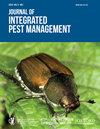核桃仁茧蜂的生物学及防治(鳞翅目:茧蜂科)
IF 2.7
3区 农林科学
Q1 ENTOMOLOGY
引用次数: 1
摘要
核桃仁的害虫,是整个美国中部和西南部以及墨西哥北部核桃仁产区的核桃仁生产的主要害虫。经济损失主要是由于第一代幼虫在春季授粉后不久就在发育中的小坚果中取食。第二代和第三代幼虫的危害也会造成经济损失。我们总结了核桃的分布、生活史、作物危害以及目前的管理措施,包括果园侦察、信息素陷阱监测成虫活动以及化学、生物和调控控制。杀虫剂是控制核桃蛀虫的唯一手段,但必须在幼虫钻入核桃之前及时将其杀死。有效的管理需要果园侦察,以评估卵丰度和幼虫进入坚果,以确定杀虫剂处理的需要和最佳时机。在线学位日模型PNCforecast利用信息素诱捕器数据预测产卵活动和取样果园的最佳日期,以评估核桃仁卵的侵染情况。二酰基肼杀虫剂对鳞翅目幼虫有毒,但保留了抑制山核桃次生害虫的有益昆虫,从而增强了该IPM计划。本文章由计算机程序翻译,如有差异,请以英文原文为准。
Biology and Management of the Pecan Nut Casebearer (Lepidoptera: Pyralidae)
The pecan nut casebearer, Acrobasis nuxvorella Neunzig, is a key pest of pecan nut production throughout the pecan producing regions of the central and southwestern United States and northern Mexico. Economic loss is primarily due to first-generation larvae that feed internally in developing nutlets soon after pollination in the spring. Damage by second-generation and third-generation larvae can also result in economic loss. We summarize pecan nut casebearer distribution, life history, crop injury, and current management practices including orchard scouting, monitoring adult activity with pheromone traps, and chemical, biological and regulatory controls. Insecticides are the sole means of controlling pecan nut casebearer but must be properly timed to kill young larvae before they tunnel into pecan nuts. Effective management requires orchard scouting to assess egg abundance and nut entry by larvae to determine the need for and optimum timing of insecticide treatment. An on-line, degree-day model, PNCforecast, uses pheromone trap data to predict oviposition activity and optimum dates for sampling orchards to assess pecan nut casebearer egg infestations. This IPM program is enhanced by the availability of diacylhydrazine insecticides that are toxic to Lepidoptera larva but preserve beneficial insects that suppress secondary pests of pecans.
求助全文
通过发布文献求助,成功后即可免费获取论文全文。
去求助
来源期刊

Journal of Integrated Pest Management
Agricultural and Biological Sciences-Insect Science
CiteScore
5.80
自引率
3.60%
发文量
24
审稿时长
25 weeks
期刊介绍:
Journal of Integrated Pest Management is an open access, peer-reviewed, extension journal covering the field of integrated pest management. The Editors-in-Chief are Dr. Marlin E. Rice (formerly with Iowa State University) and Dr. Kevin L. Steffey (formerly with the University of Illinois). The journal is multi-disciplinary in scope, publishing articles in all pest management disciplines, including entomology, nematology, plant pathology, weed science, and other subject areas.
 求助内容:
求助内容: 应助结果提醒方式:
应助结果提醒方式:


